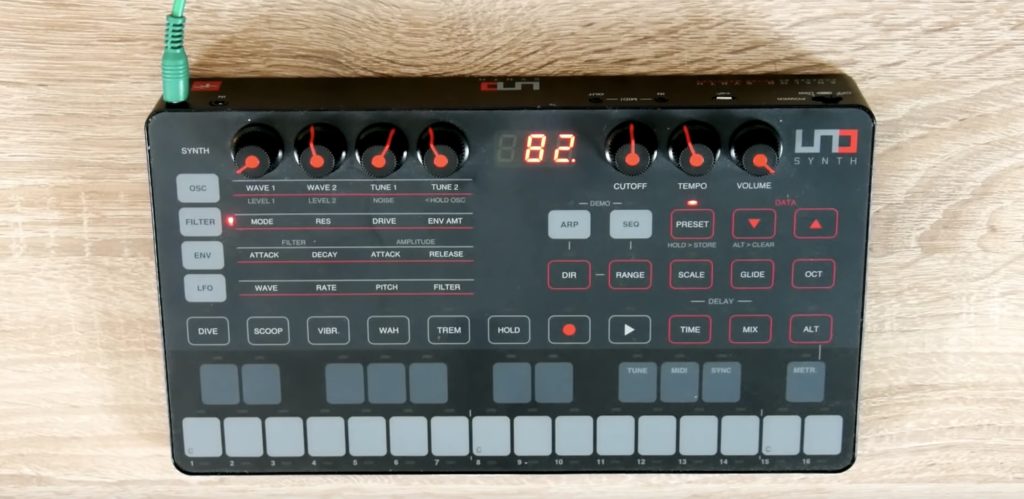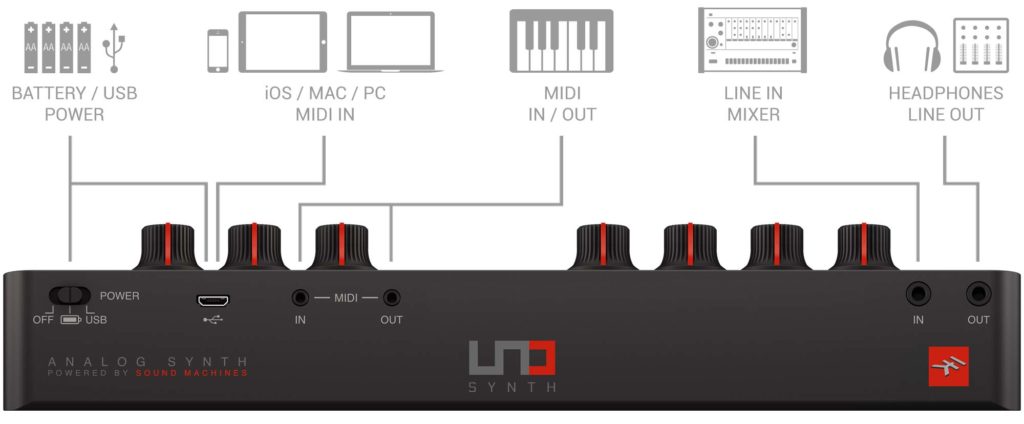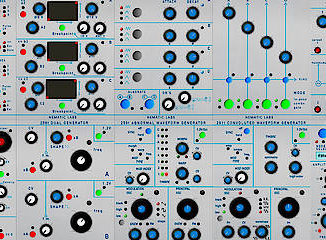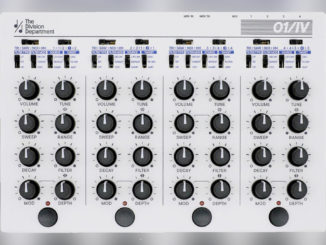IK Multimedia’s Uno Synth is the company’s first hardware Synthesizer. So far they trusted on software synths products like the various sample libraries for SampleTank or Syntronik. With the UNO-Synth they go new but also known ways: analog, inexpensive but also portable.
For the realization, the IK team worked with Davide Mancini from Soundmachines and longterm collaborator Erik Norlander. The result is a portable Synthesizer with a 100% analog signal flow.
Unboxing
The UNO-Synth is delivered with a multilingual quick guide, four AA batteries, a USB cable as well as two MIDI din cables. A complete manual is not in the box but is only available for download.
Unpacking the UNO Synth for the first time clearly shows that it’s designed differently. So you don’t find here a classical (white/black) keyboard but a touch surface that is accompanied with 7 parameter knobs. The first hours were a bit strange because without watching, you can not see what you are pushing. After long playing, I can say that the touch keyboard is not perfect but also not bad.
For the current asking price, this keyboard is very good and I like it better than this from the KORG Volca series. If this were installed in a 500+ € Synthesizer, the criticism would be of course louder. The plastic knobs are not very high in quality but are smooth and comfortable to use.
Backside
On the back, there is a power switch with which you can power the Uno Synth either via 4 classic AA batteries or USB. In the test, the synth was almost only operated with a USB power supply. The battery operation is a nice extra feature that makes the device very portable.
If you go into the park, you can use these, but in the studio, I recommend to use the USB port. The latter one is also used for firmware updates and the full integration into a DAW using the free editor for PC/Mac/iOS. Next, you have MIDI support over USB and over MIDI In/Out DIN cables. Not perfect, but understandable due to the limited space in the unit.
Last but not least, there is an audio input on the right side as well as an audio output, which also works as a headphone out. It’s a pity here that the audio input does not pass the signal into the analog filter. Also, the combo version of the audio output could not completely convince.
It always takes a while to get the headphones working. So an additional stereo headphone output would be here a good update.
Straightforward Analog Synthesis
Editor
Yes, the UNO Synth is usable with any DAW and offers a complete MIDI implementation with all parameters with MIDI CC. With the free editor, you can record parameters and recall/save patches very easily in your DAW. All changes made on the software editor track to the hardware unit in real time and vice versa. It’s a feature that works without any noticeable delay and is really positive to see in the price range.
Access to the individual parameters automations is unfortunately not available in the editor what is a bit pity in my opinion. So the editor serves more the synthesis and patch recalling part of the UNO-Synth than the performance side.
A Sequencer That Makes A Lot Of Fun
In addition to a built-in arpeggiator with various modes, the UNO-Synth has a creative 16 step sequencer. Yes, it’s a shame that it has only 16 steps, more steps would have been more useful.
Nonetheless, the exciting thing about the sequencer is the parameter automation function, which allows you to record up to 20 different parameters. With this, you can program very subtle changes up to extreme modulations. Automations can be programmed in real time or per step. This works very well and with the LED’s on the sequencer, you can see well what you record. If you put movements on the right steps, you can even design a kind of drum machine. It is a bit pity that you cannot load and edit all these parameter automation directly in the editor. That would be super handy.
Sound Impressions
The most important thing about a Synthesizer is probably the sound. The entire sound of the UNO-Synth was convincing in the test. He is mostly in the classically analog home but features like the parameter recording bring some crazy timbres at the table. It would certainly have been more exciting if the developers have had built sync or even FM into the engine.
Especially the combination of the slightly aggressive filter and the sequencer, you can quickly drift off into acid landscapes. For the recent street price of 200€, it’s hard to say something against the sound. The UNO Synth certainly does not have the sound depth and richness of a Moog Minimoog or Oberheim Synthesizer (two different leagues of course) but it can score with its own nice sound character. For portable use or for beginners in any case sufficiently versatile.
Final Review
IK Multimedia’s first hardware Synthesizer is just unlike many others. One did not try to reproduce an instrument of the past but designed a completely new one based on their own ideas. The UNO Synth left me with the impression that it’s a Synthesizer for everyone, from newcomers to professionals: discover playful analog synthesis without diving deep in the technology.
It’s portable, easy-to-use and sounds very good. Certainly, not everything is perfect on the UNO Synth (no FM/sync, only 16 steps…) but for a first hardware Synthesizer at this price point (+ made in Italy), I can only say good work. It will be interesting to see what the former only software company will do in the hardware synth field in the future. The first step they have successfully mastered.
Pro
- compact & portable
- battery-powered operation
- sound quality
- unique sound character
- sequencer with automation
- updates
Neutral
- knobs & touch keyboard
- audio input
Contra
- no oscillator FM/Sync
- sequencer only 16 steps
- no PWM access (only editor)
- audio output







Be the first to comment